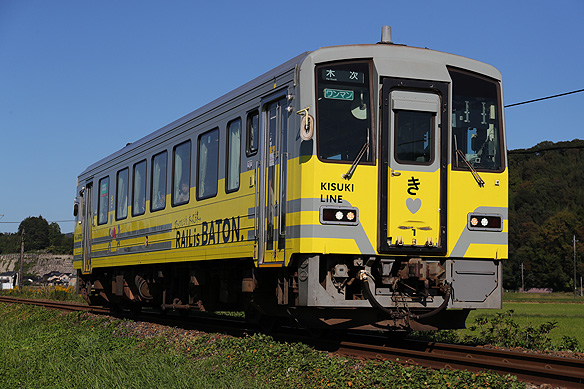Background and overview
JR West developed class kiha120-0 single-car diesel multiple unit (DMU) train featuring longitudinal bench seating accommodation in 1993 after JR West developed class kiha120-200 DMU featuring the accommodation consisting of transverse seating bays and longitudinal bench seating. 22 vehicles were built and 6 vehicles were delivered to Yonago depot, 10 Kameyama depot, and 6 Ogori depot in 1993.
Car body
They have 15800mm long and 2800mm wide body having 2 cabs at the ends of
their body. Their body design incorporates lightweight stainless steel
excepting cab ends constructed by steel. Cab ends have a gangway and a
storable gangway connection. The upper part of the cab end is slanted at
7 degrees. Two rectangular headlights employing sealed beam light bulbs
and two rectangular tail lights are fitted each side of the gangway. They
are equipped with two 900mm wide stepped folding doors and fixed windows
between the doors. Door operating equipment is TR10D or TR10F developed
for the bus. Each door can be opened separately for conductor-less operation.
Each door has a handle to open manually to prevent the passenger's room
from being cold in winter while stopping at the station long time for train
meet on a single-track line. They employ an air conditioner, DDL-2CS-455X,
rated at 20,600kcal/h, of which indoor unit is fitted on their roof and
of which outdoor unit is fitted under their floor and driven by their prime
mover. Electric fans are fitted on the both side of the air conditioner.
Bodies are unpainted and have the coloured bands on each side of the body.
Bogies
They are equipped with a WDT54 powered bogie and a WTR238 trailer bogie featuring diaphragm airbags for the secondary suspension, buffer rubber type journal supporting system, and sealed roller bearings. Powered bogie features 2-axle drive for anti-slip. Their bogies apply the single tread brake device for motored bogies and the disk brake device powered by the body mounted brake cylinder. The wheel diameter is 860mm and the wheel base is 1900mm.
Traction unit and ancillary equipments
They are powered by a four-cycle flat-six diesel prime mover, SA6D125-H-1 of Komatsu Ltd., with a power output of 330PS employing a turbocharger powered by the flow of exhaust gas. They are also equipped with the hydraulic transmission gear, TACN-22-1605, employing three-member one-stage torque converter and a water-cooled air compressor, C600, powered by a prime mover. Their brake system is automatic brake with exhaust brake applying butterfly valve.
Accommodation
Seating is arranged as longitudinal bench seating throughout to ease boarding and alighting. The ticket machine, which put the ticket indicating the boarding station, is located beside doorways at the end of their body. The fare chart seven segment display and the fare box are located behind the driver's cab. Their cab is a compartment type located at the left side of the train. They are equipped a casement window for rear view confirmation due to no hinged door for the driver.
Modification and refurbishment
JR West carried out to fit them with an additional western style toilet over the period from 2004 until 2007 after receiving many requests of toilet installation from various quarters. Only a water tank is located under the floor. On the other hand, the sanitation system for the toilet is located on the floor to reduce the impacts against underfloor equipments. As a result, some bench seating was removed and a window is filled with an additional plate to fit the with a toilet.
Furthermore, refurbish programme was commenced on class kiha120-200 in 2017. Seat partitions fitted at the both end of seating was enlarged and intermediate seat partitions were introduced. Their seats got wider than before and the fabric of the seat is replaced. LED headlights were also employed. A body vibration detector (BVD) applying accelerometers is fitted near their bogies to prevent damage caused by derailment and collision to name a few from spreading.
Operations
They entered the revenue services on Kansai line between Kameyama and Kamo, Sai-in line, Kisuki line, Sanko line and Mine lines in 1993. They are now used on the rural services on each line excepting Sanko line. |
|

